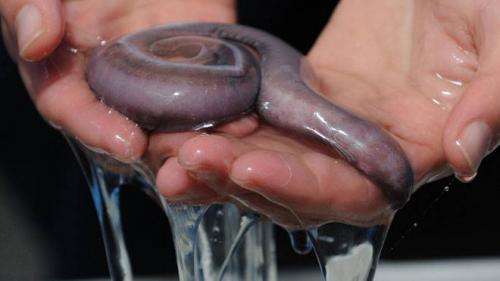Hagfish Slime. Credit: The Canadian Press
(Phys.org) —Perhaps the worst fate to be had in the sea is to be slimed by the hagfish. The proteinaceous goo they secrete has gotten many a hagfish out of bind by gumming up the gills and suffocating a would be attacker. The slime's prodigious strength and even more remarkable fecundity has attacked the attention of several scientists now trying to replicate it in the lab. While scientists are just begining to understanding how the so-called gland thread cells (GTCs) that produce the slime might actually work, others are already seeking to commercialize the slime as a high performance fiber.
Benthic labs is a synthetic biology startup comprised of students from the College of Science Engineering and Food Science (SEFS) in University College Cork. They envision slime as a material that could have uses in everything from clothing and body armour to applications in the medical field. They believe that the slime could replace many products that now ultimately derive from the petroleum industry. Slime is no slouch when it comes to material properties—on a weight basis it is five times stronger than steel. At 800 megapascals, it is nearly as strong as spider silk (1 gigapascal), which is made primarily from a similar intermediate filament (IF) protein. For those wanting to go full bio and build an all natural spidey-suit, we note that the strongest mussel-derived glue can only withstand 800,000 pascals (N/m2) on polar surfaces and 30 000 on non-polar. Slime based webs or cables would therefore be up to the job.
Each IF thread is a mere 12 nm wide but 15 cm long. Reminiscent of viruses which can pack huge lenghts of DNA into miniscule volumes, each thread is compactly coiled up into 15 or 20 layers inside of a single GTC. The thickness of IFs falls right between the two other main structural polymers found in cells, namely actin filaments (7nm) and microtubules (25 nm). The basic unit of the intermediate filament (IF) is an anti-parallel oriented tetramer. Unlike the parallel oriented actin or microtubule filaments, which have a plus end and a minus end, IFs lack any obvious polarity that would lend themselves to cell motility or directed intracellular transport.
The strategy at Benthic Labs is to put hagfish DNA for the slime filament proteins into a plasmid which is in turn put into bacteria. The bacteria then presumably produces the protein in huge amounts. If their product is to make it on merit, they are probably going to need more than an IF soup to get the numbers quoted above. Real biofibers like silk are more than fancy versions of the keratin IFs in our hair and nails. Many other proteins come into play as the fibers are mixed and formed. For hagfish slime, extremely rapid expansion not only key to building slime, it is the difference between life and death. In part, the volume building formula is facilitated by mucin vessicles. They are simultaneously released with slime to help generate the hydrodynamic forces for needed for unraveling.
There is also believed to be some kind of a seawater-soluble glue than is dissolved to release elastic energy stored in the fibers once the slime hits the water. In that way, just a few cupfuls of gland cell secretion containing some 25,000 thread fibers can rapidly turn into buckets of attack sauce. If the seawater requirement can be eliminated, we might see more terrestrial application emerge. For example, we could have the makings for a fantastic automotive airbag, provided one can deal with getting slimed. Like spider silk the road to replication and production may be long, but several folks are betting the obstacles can be surmounted.
More information: — Spontaneous unraveling of hagfish slime thread skeins is mediated by a seawater-soluble protein adhesive, J Exp Biol 217, 1263-1268. jeb.biologists.org/content/217/8/1263.abstract
— Coiling and maturation of a high-performance fibre in hagfish slime gland thread cells, Nature Communications 5, Article number: 3534, www.nature.com/ncomms/2014/140 … full/ncomms4534.html
Journal information: Nature Communications
© 2014 Phys.org























